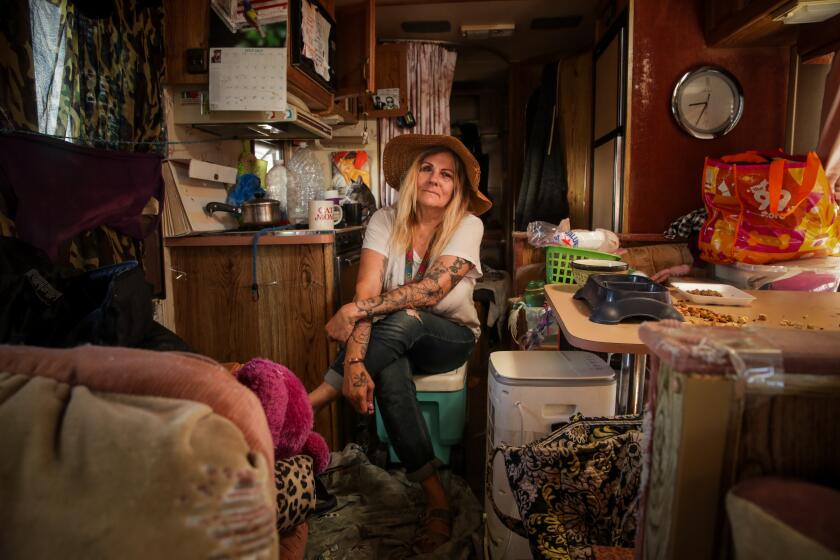Intimate partner violence is a precursor to homelessness, study finds
- Share via
One in five women who become homeless in California flee their homes to escape violence and escalating abuse by an intimate partner, a new analysis of a statewide survey has reported.
The study by the Benioff Homelessness and Housing Initiative at UC San Francisco found that a dearth of domestic violence shelters leaves women exposed to more violence in homeless encampments.
“That system is completely overwhelmed, and people are winding up in encampments,” said Margot Kushel, director of the research group and co-author of the report.
Among those who reported being victims of violence in the six months before losing their housing, 2 in 5 were victimized again while homeless, usually at the hands of a former partner who tracked them down.
The report made several policy recommendations: more domestic violence shelters, better coordination of the intake system to those shelters and other services, and more permanent housing to create a path out of shelters.
“What the domestic violence system also needs is the ability to move people on to a place that is safe,” Kushel said. “There is a huge shortage of domestic violence beds.”
As L.A. officials and residents push to get rid of RV encampments, one woman’s story reflects the mountainous obstacles faced by those who try to find housing.
Inefficiencies and confusion in the system are also a factor, said Debbie Chang, president and chief executive of the Blue Shield of California Foundation, which helped fund the study.
“Sometimes what happens is a survivor will try to access the homelessness system, the intake worker will say, ‘You have domestic violence. You have to go to a domestic violence shelter.’ Or they don’t accept children. The survivor is fleeing with children.”
Of those who experienced intimate partner violence in the six months prior to homelessness, only 12% sought help from a domestic violence organization and 10% received help.
“Some people honestly had no idea what is a domestic violence shelter,” Kushel said. “Other people told us when they had to run, they had to run. They didn’t have time to figure out where to find a shelter. “
In the survey, 17% of homeless women reported experiencing intimate partner violence in the six months before becoming homeless.
Kushel said some had first moved in with friends or family members to escape violence. Others had spent time in jail after police hauled off both parties to a violent episode.
Predictably, the report found that poverty is a factor, disproportionately affecting minority populations.
After Tonnietta Mauricico was stalked and raped in Minneapolis, her attacker went to jail.
While domestic violence affects all ethnic groups and income levels, women of color “are more likely to be rent burdened, have extremely low incomes, and face a host of housing barriers rooted in legacies of racism and contemporary discrimination,” the report said.
“In my opinion, probably 90% of the people that are in abusive relationships would get out if they had an out to go to, if they weren’t going to lose their kids, their home, their financial ability to function day to day,” said a 43-year-old woman quoted anonymously in the report.
Participants described needing time to plan their exit in advance and to accumulate resources such as money, phones and other essentials without their partner knowing.
For that reason, the report found, cash payments could help victims of intimate partner violence overcome hurdles to getting reestablished, such as transportation and child care.
More than 80% of women victimized by intimate partner violence in the six months prior to homelessness believed that a lump-sum payment would have helped them stave off homelessness.
The report on intimate partner violence is a follow-up to the California Statewide Study of People Experiencing Homelessness published in June.
That study, based on 3,200 questionnaires and 365 in-depth interviews, probed the pathways to homelessness, experiences during homelessness and barriers to regaining permanent housing.
It found that lifetime experiences of discrimination, exposure to violence, incarceration and other traumas increase vulnerability to homelessness and that physical and sexual victimization were common.
The analysis on intimate partner violence delved deeper into what Kushel characterized as an insidious precursor to homelessness.
That connection can be so strong that 1 in 5 women fleeing an abusive relationship gave up housing with a lease.
“Very few people who wind up homeless left something where they had a voucher,” Kushel said. “This was the exception.”
Fifteen percent of all cisgender women experienced continued violence while homeless. For those who had reported violence prior to becoming homeless, that rate jumped to 40%.
“The people in encampments told us their perpetrators were finding them,” Kushel said. “They told us harrowing stories about moving to keep ahead of the perpetrator.”
In contrast, those who found refuge in domestic violence shelters “were not experiencing domestic violence.”
“If you want to solve homelessness you have to address domestic violence,” said Chang of the Blue Shield foundation, whose mission is finding solutions to domestic violence. “We really can’t solve one without addressing the others.”
More to Read
Sign up for Essential California
The most important California stories and recommendations in your inbox every morning.
You may occasionally receive promotional content from the Los Angeles Times.















